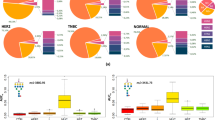Abstract
Quantitative profiling of glycans with different structures appears essential for a better understanding of the cellular adhesion phenomena associated with malignant transformation and the underlying aberrant glycosylation of cancer cells. Using the recently developed glycomic techniques and mass-spectrometric measurements, we compare the N-linked and O-linked oligosaccharide profiles for different breast cancer cell lines with those of normal epithelial cells. Statistically significant differences in certain neutral, sialylated and fucosylated structures are readily discerned through quantitative measurements, indicating a potential of distinguishing invasive and non-invasive cancer attributes. The glycomic profile data cluster accordingly using Principal Component Analysis, verifying further glycobiological differences due to the differences between normal and cancer cell lines.












Similar content being viewed by others
References
Tang, D.G., Honn, K.V.: Adhesion molecules and tumor metastasis: an update. Invasion Metastasis 14(1–6), 109–122 (1994)
Kannagi, R.: Carbohydrate-mediated cell adhesion involved in hematogenous metastasis of cancer. Glycoconj. J. 14(5), 577–584 (1997)
Fukuda, M.: Possible roles of tumor-associated carbohydrate antigens. Cancer Res. 56(10), 2237–2244 (1996)
Kansas, G.S.: Selectins and their ligands: current concepts and controversies. Blood 88(9), 3259–3287 (1996)
Leong, S.P., et al.: Clinical patterns of metastasis. Cancer Metastasis Rev. 25(2), 221–232 (2006)
Kang, P., et al.: Comparative glycomic mapping through quantitative permethylation and stable-isotope labeling. Anal. Chem. 79(16), 6064–6073 (2007)
Kyselova, Z., et al.: Breast cancer diagnosis and prognosis through quantitative measurements of serum glycan profiles. Clin. Chem. 54, 1166–1175 (2008)
Hathout, Y., et al.: Proteomic phenotyping: metastatic and invasive breast cancer. Cancer Lett. 210(2), 245–253 (2004)
Jiang, D., et al.: Identification of metastasis-associated proteins by proteomic analysis and functional exploration of interleukin-18 in metastasis. Proteomics 3(5), 724–737 (2003)
Kluger, H.M., et al.: cDNA microarray analysis of invasive and tumorigenic phenotypes in a breast cancer model. Lab. Invest. 84(3), 320–331 (2004)
Nishizuka, I., et al.: Analysis of gene expression involved in brain metastasis from breast cancer using cDNA microarray. Breast Cancer 9(1), 26–32 (2002)
Tanaka, H., et al.: Differential gene expression screening between parental and highly metastatic pancreatic cancer variants using a DNA microarray. J. Exp. Clin. Cancer. Res. 22(2), 307–313 (2003)
Bjerner, J., et al.: MUC1 serum assays in breast cancer: tumor specificities and reference levels. Tumour Biol. 23(6), 315–323 (2002)
Rakha, E.A., et al.: Expression of mucins (MUC1, MUC2, MUC3, MUC4, MUC5AC and MUC6) and their prognostic significance in human breast cancer. Mod. Pathol. 18(10), 1295–1304 (2005)
Miyamoto, S.: Clinical applications of glycomic approaches for the detection of cancer and other diseases. Curr. Opin. Mol. Ther. 8(6), 507–513 (2006)
Novotny, M.V., Mechref, Y.: New hyphenated methodologies in high-sensitivity glycoprotein analysis. J. Sep. Sci. 28(15), 1956–1968 (2005)
Raman, R., et al.: Glycomics: an integrated systems approach to structure–function relationships of glycans. Nat. Methods 2(11), 817–824 (2005)
An, H.J., et al.: Profiling of glycans in serum for the discovery of potential biomarkers for ovarian cancer. J. Proteome Res. 5(7), 1626–1635 (2006)
Kirmiz, C., et al.: A serum glycomics approach to breast cancer biomarkers. Mol. Cell Proteomics 6, 43–55 (2007)
Kyselova, Z., et al.: Alterations in the serum glycome due to metastatic prostate cancer. J. Proteome Res. 6, 1822–1832 (2007)
Kang, P., et al.: Solid-phase permethylation of glycans for mass spectrometric analysis. Rapid Commun. Mass Spectrom. 19(23), 3421–3428 (2005)
Mechref, Y., Kang, P., Novotny, M.V.: Differentiating structural isomers of sialylated glycans by matrix-assisted laser desorption/ionization time-of-flight/time-of-flight tandem mass spectrometry. Rapid Commun. Mass Spectrom. 20(8), 1381–1389 (2006)
Huang, Y., et al.: Matrix-assisted laser desorption/ionization mass spectrometry compatible beta-elimination of O-linked oligosaccharides. Rapid Commun. Mass Spectrom. 16(12), 1199–1204 (2002)
Huang, Y., Mechref, Y., Novotny, M.V.: Microscale nonreductive release of O-linked glycans for subsequent analysis through MALDI mass spectrometry and capillary electrophoresis. Anal. Chem. 73(24), 6063–6069 (2001)
Wada, Y., Azadi, P., Costello, C., Dell, E.A., Dwek, R.A., Geyer, H., et al.: Glycobiology 17, 411–422 (2007)
Kui Wong, N., et al.: Characterization of the oligosaccharides associated with the human ovarian tumor marker CA125. J. Biol. Chem. 278(31), 28619–28634 (2003)
Nuck, R., et al.: Comparative study of high-mannose-type oligosaccharides in membrane glycoproteins of rat hepatocytes and different rat hepatoma cell lines. Eur. J. Biochem. 216(1), 215–221 (1993)
Asada, M., et al.: Increased expression of highly branched N-glycans at cell surface is correlated with the malignant phenotypes of mouse tumor cells. Cancer Res. 57(6), 1073–1080 (1997)
Fuster, M.M., et al.: A disaccharide precursor of sialyl Lewis X inhibits metastatic potential of tumor cells. Cancer Res. 63(11), 2775–2781 (2003)
Alper, J.: Glycobiology. Turning sweet on cancer. Science 301(5630), 159–160 (2003)
Brown, J.R., et al.: A disaccharide-based inhibitor of glycosylation attenuates metastatic tumor cell dissemination. Clin. Cancer Res. 12(9), 2894–2901 (2006)
Soule, H.D., et al.: Isolation and characterization of a spontaneously immortalized human breast epithelial cell line, MCF-10. Cancer Res. 50(18), 6075–6086 (1990)
Nishizuka, S., et al.: Proteomic profiling of the NCI-60 cancer cell lines using new high-density reverse-phase lysate microarrays. Proc. Natl. Acad. Sci. U. S. A. 100(24), 14229–14234 (2003)
Bradford, M.M.: A rapid and sensitive method for the quantitation of microgram quantities of protein utilizing the principle of protein-dye binding. Anal. Biochem. 72, 248–254 (1976)
Verhoeckx, K.C., et al.: A combination of proteomics, principal component analysis and transcriptomics is a powerful tool for the identification of biomarkers for macrophage maturation in the U937 cell line. Proteomics 4(4), 1014–1028 (2004)
Acknowledgements
This work was supported by grants No. GM24349 from the National Institute of Health (NIH) and No. RR018942 from NCRR/NIH as a contribution from the National Center for Glycomics and Glycoproteomics at Indiana University. The initial stages of this investigation were also aided by a grant from the twenty-first Century Fund of the State of Indiana.
Author information
Authors and Affiliations
Corresponding authors
Rights and permissions
About this article
Cite this article
Goetz, J.A., Mechref, Y., Kang, P. et al. Glycomic profiling of invasive and non-invasive breast cancer cells. Glycoconj J 26, 117–131 (2009). https://doi.org/10.1007/s10719-008-9170-4
Received:
Revised:
Accepted:
Published:
Issue Date:
DOI: https://doi.org/10.1007/s10719-008-9170-4




